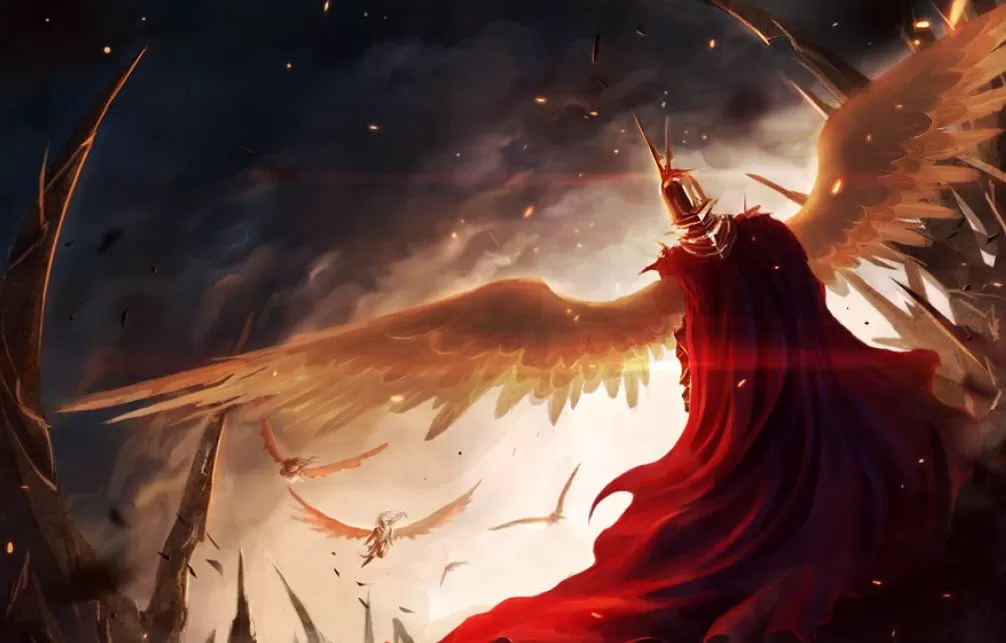
Devils
The very name whispers chilling tales of forbidden allure, malevolent wickedness, and spine-tingling confrontations. In the labyrinthine corridors of the Nine Hells, an unspeakable variety of infernal adversaries lie in wait- from the wretched lemures that crawl in the shadows to the monolithic pit fiends that reign with terror. Yet, the devils detailed in the Monster Manual often suffer from a debilitating flaw: they lack the pulse-pounding dynamism to make your players' hearts race.
If you're simply deploying these devils as expendable pawns, this deficiency may be forgivable. However, if you're orchestrating a campaign as gripping and soul-consuming as Baldur's Gate: Descent into Avernus, mediocrity is a sin you cannot afford. We delve into the darkest corners of the Monster Manual, unearthing the latent potential and shortcomings of these hellish entities, before breathing new, unholy life into them with alternative abilities.
Our objective is not to amplify their raw power-no increase in hit points, AC, or devastating attacks. Rather, we strive to inject them with an exhilarating sense of unpredictability and tactical depth. Enhanced versatility may not render them weaker, but that's a price we willingly pay for a diabolical chess game that's infinitely more electrifying, whether you're the puppeteer or the prey.
To ease the infernal management on your end, all alterations are highlighted in hues as fiery as the Hells themselves. We also integrate most spells and tactical options directly into their stat blocks, endowing your devils with multidimensional complexity without complicating your role as the dark conductor of their fates.
Lemure
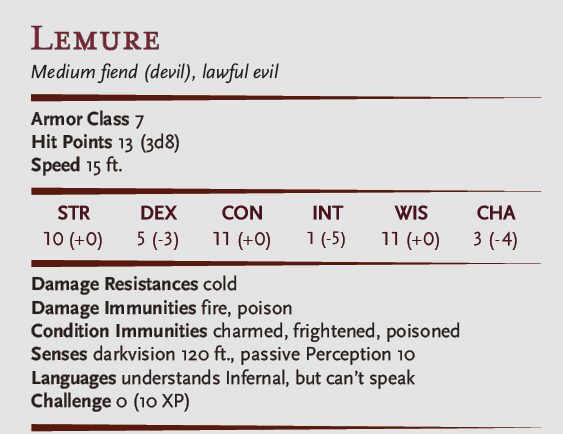
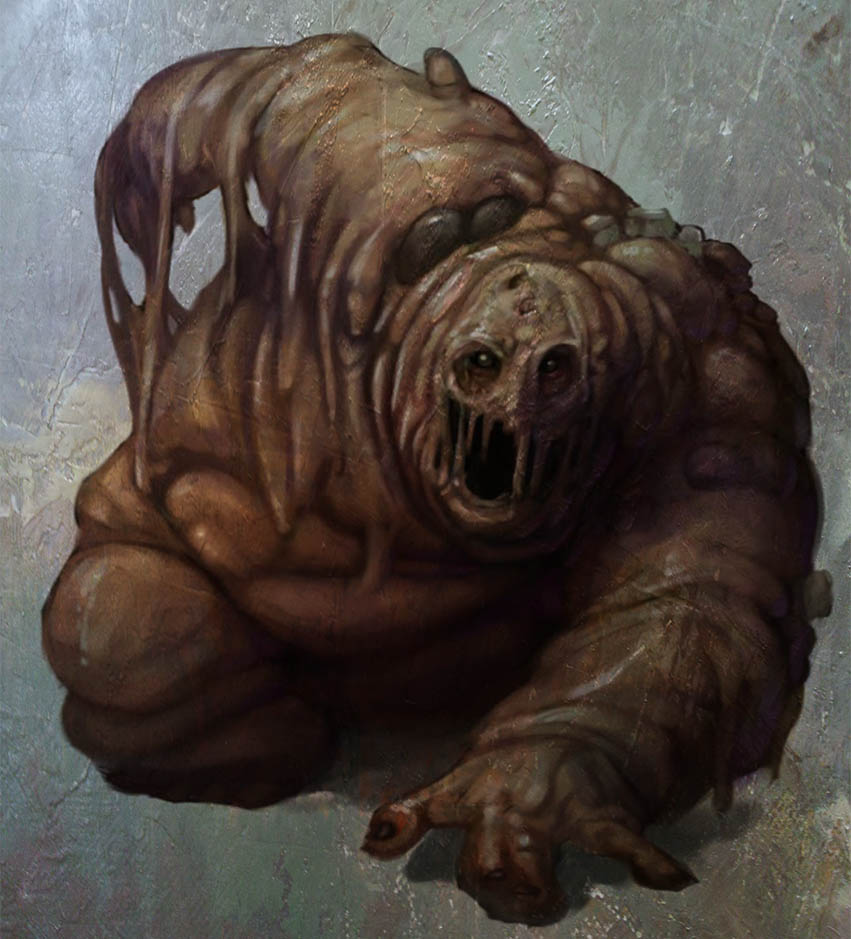
Devil's Sight. Magical darkness doesn't impede the lemure's darkvision.
Hellish Rejuvenation. A lemure that dies in the Nine Hells comes back to life with all its hit points in 1d10 days unless it is killed by a good-aligned creature with a bless spell cast on that creature or its remains are sprinkled with holy water.
Actions
Fist. Melee Weapon Attack: +2 to hit, reach 5 ft. Hit: 2 (1d4) bludgeoning damage.
Pitiful Babble. Each creature within 10 ft. of the lemure that can hear it must make a DC 10 Wisdom
saving throw. On a failure, the creature has disadvantage on the next attack roll or
ability check it makes until the end of its next turn.
Imp
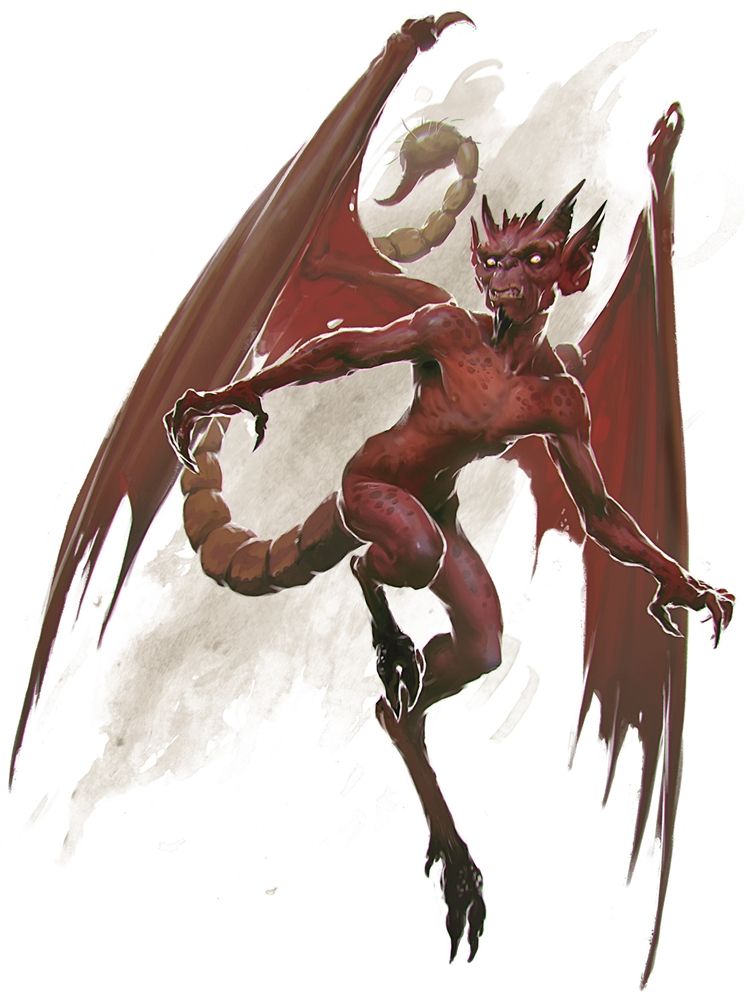
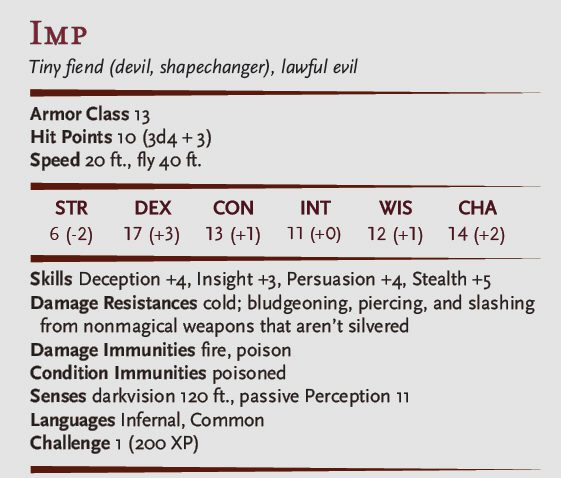
Shapechanger. The imp can use its action to polymorph into a beast form that resembles a rat (speed 20 ft.), a raven (20 ft., fly 60 ft.), or a spider (20 ft., climb 20 ft.), or back into its true form. Its statistics are the same in each form, except for the speed changes noted. Any equipment it is wearing or carrying isn't transformed. It reverts to its true form if it dies.
Devil's Sight. Magical darkness doesn't impede the imp's darkvision.
Magic Resistance. The imp has advantage on saving throws against spells and other magical effects.
Actions
Sting (Bite in Beast Form). Melee Weapon Attack: +5 to hit, reach 5 ft. Hit: 5 (1d4 + 3) piercing damage, and the target must make a DC 11 Constitution saving throw, taking 10 (3d6) poison damage on a failed save, or half as much damage on a successful one.
Invisibility. The imp magically turns invisible until it attacks or until its concentration ends (as if concentrating on a spell). Any equipment the imp wears or carries is invisible with it.
Vicious Mockery. A target within 60 ft. that can hear the imp (though it doesn't need to able to understand it), must succeed on a DC 12 Wisdom saving throw or take 1d4 psychic damage and have disadvantage on the next attack roll it makes before the end of its next turn.
Spined Devil
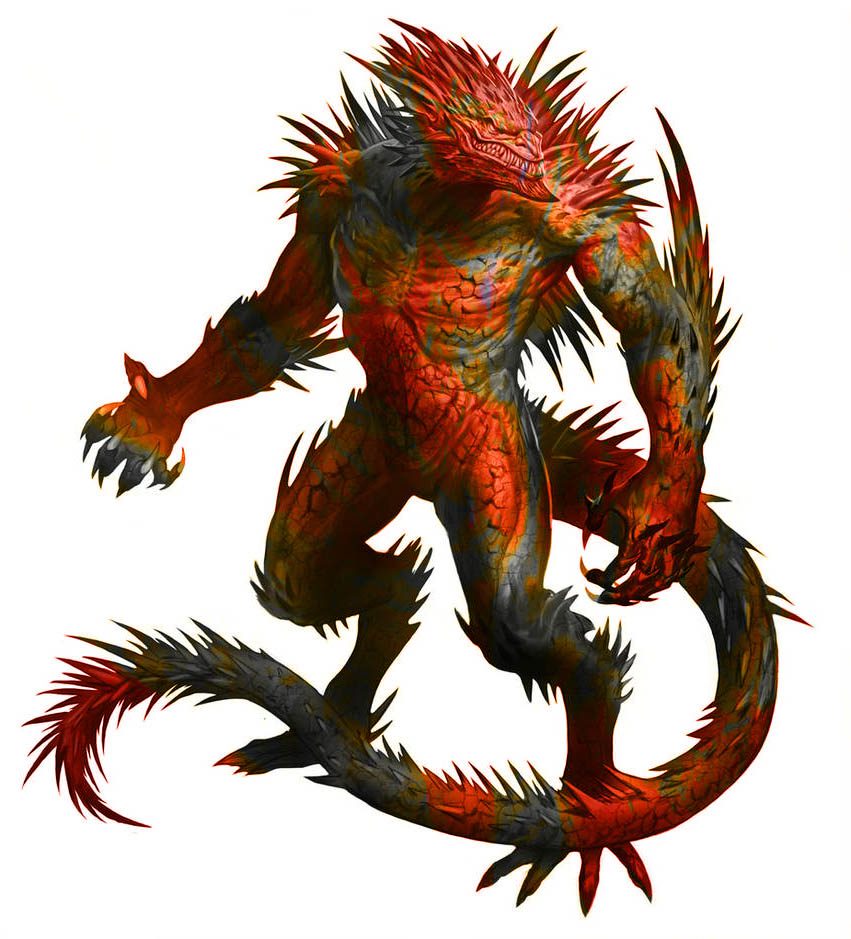
The spined devil is a fun and versatile devil suitable for low-level parties. It can fly and has both melee and ranged attacks. Beyond that, however, the spined devil isn't very notable - all it can do is damage, and against strong characters, it's little more than a glorified gnat. To give it some more versatility, we've added two new features: Reckless Dive and Searing Spines.
Reckless Dive: this feature doesn't necessarily provide the devil with a new option, as much as it makes using melee attacks more enticing. Allowing the spined devil to expose itself to gain advantage on attacks and deal extra damage gives it a valid tactical choice in combat. Granted, it's not an option the spined devil is likely to use frequently, unless on the material plane, where death isn't permanent, or if ordered by a devil of higher rank.
Searing Spines: this area of effect-feature provides the spined devil with a quick effect it can use in close quarters. By showering its enemies with searing sparks, it can deal a little damage and potentially blind its foes temporarily. A good option when surrounded or facing enemies with high AC.

Devil's Sight. Magical darkness doesn't impede the spined devil's darkvision.
Flyby. The spined devil doesn't provoke opportunity attacks when it flies out of an enemy's reach.
Limited Spines. The devil has twelve tail spines. Used spines regrow by the time the devil finishes a long rest.
Magic Resistance. The spined devil has advantage on saving throws against spells and other magical effects.
Actions
Multiattack. The devil makes two attacks: one with its bite and one with its fork or two with its tail spines.
Bite. Melee Weapon Attack: +2 to hit, reach 5 ft. Hit: 5 (2d4) piercing damage.
Fork. Melee Weapon Attack: +2 to hit, reach 5 ft. Hit: 3 (1d6) piercing damage.
Tail Spine. Ranged Weapon Attack: +4 to hit, range 20/80 ft.
Hit: 4 (1d4 + 2) piercing damage plus 3 (1d6) fire damage.
Reckless Dive. The devil flies up to its speed towards a target creature, which can make an opportunity attack against the devil as a reaction, when it comes within reach. If the devil survives, it can then make a Bite attack and a Fork attack against that creature with advantage, dealing an additional 1d6 piercing damage on a successful hit.
Searing Spines. The devil shakes itself, showering nearby creatures with burning-hot spine-splinters. Each creature within 10 ft. of the devil must make a DC 12 Constitution saving throw. On a failure, it takes 7 (2d6) fire damage and is blinded until the end of its next turn. On a success, it takes only half damage and isn't blinded.
Ice Devil
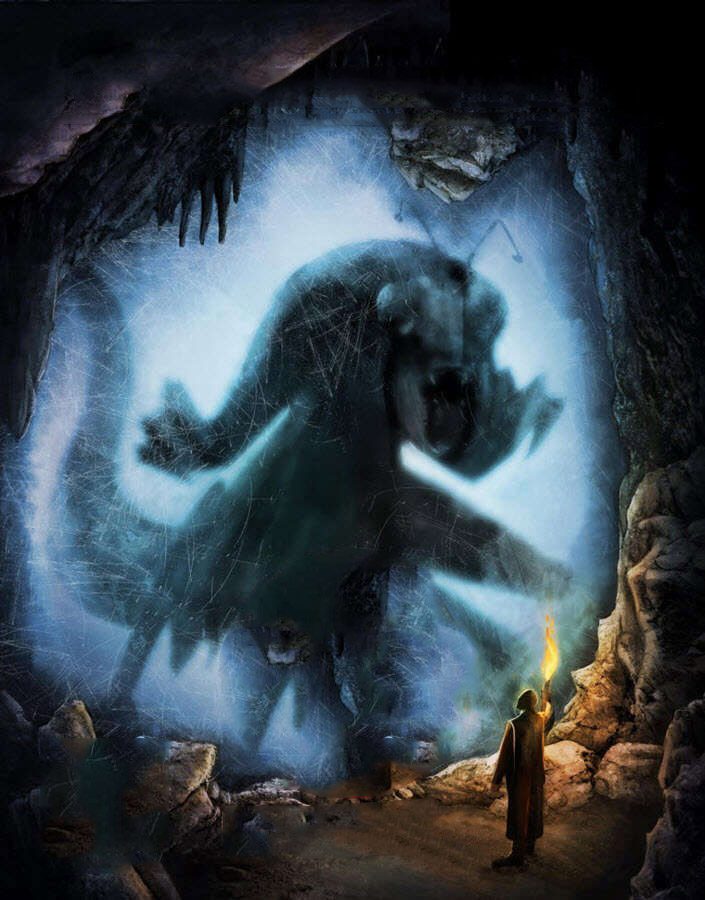
The ice devil is a flavorful foe with a heavy damage output - an average of 64 damage when using all three attacks - and a decent body. It even comes with a very fitting and powerful feature, Wall of Ice, which it can use to great effect. Still, while the Wall of Ice is recharging, the Ice Devil has nothing else to do but attack - which isn't all that exciting.
In the Monster's Manual we're given the option for an ice devil with a spear, which it seems foolish not to use - so we've added it directly to the stat block. To round out its options, we've also given it the Ice Knife-feature.
Ice Spear: Using Ice Spear instead of Bite and Claws comes out to less damage, but the possibility of seriously
a foe while keeping combat at a pleasant 10 ft. range makes this a viable combat option.
Ice Knife: This simple 1st-level spell - beefed up to 5th level and given some extra damage - gives the Ice Devil a ranged attack option, which it sorely needs. While only truly impactful when enemies are clustered tightly together, it's bound to come in handy in situations where melee attacks aren't an option.
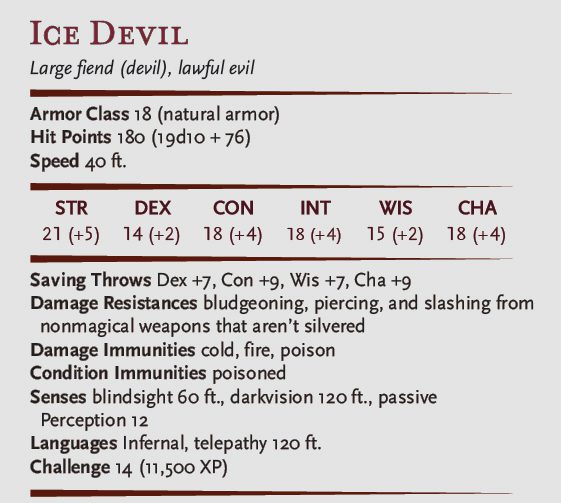
Devil's Sight. Magical darkness doesn't impede the devil's darkvision.
Magic Resistance. The devil has advantage on saving throws against spells and other magical effects.
Actions
Multiattack. The devil makes three attacks: one with its bite, one with its claws, and one with its tail, or: two attacks: one with its spear and one with its tail.
Ice Spear. Melee Weapon Attack: +10 to hit, reach 10 ft., one target. Hit: 14 (2d8 + 5) piercing damage plus 10 (3d6) cold damage. If the target is a creature, it must succeed on a DC 15 Constitution saving throw, or for 1 minute, its speed is reduced by 10 feet; it can take either an action or a bonus action on each of its turns, not both; and it can't take reactions. The target can repeat the saving throw at the end of each of its turns, ending the effect on itself on a success.
Bite. Melee Weapon Attack: +10 to hit, reach 5 ft. Hit: 12 (2d6 + 5) piercing damage plus 10 (3d6) cold damage.
Claws. Melee Weapon Attack: +10 to hit, reach 5 ft. Hit: 10 (2d4 +5) slashing damage plus 10 (3d6) cold damage.
Tail. Melee Weapon Attack: +10 to hit, reach 10 ft. Hit: 12 (2d6 + 5) bludgeoning damage plus 10 (3d6) cold damage.
Ice Knife. Ranged Spell Attack: +9 to hit, range 60 ft. Hit: 27 (5d10) piercing damage. Hit or miss, the target and each creature within 5 feet of it must succeed on a DC 17 Dexterity saving throw or take 21 (6d6) cold damage.
Wall of Ice (Recharge 6). The devil magically forms an opaque wall of ice on a solid surface it can see within 60 feet of it. The wall is 1 foot thick and up to 30 feet long and 10 feet high, or it's a hemispherical dome up to 20 feet in diameter. When the wall appears, each creature in its space is pushed out of it by the shortest route. The creature chooses which side of the wall to end up on, unless the creature is incapacitated. The creature then makes a DC 17 Dexterity saving throw, taking 35 (10d6) cold damage on a failed save, or half as much damage on a successful one.
The wall lasts for 1 minute or until the devil is incapacitated or dies. The wall can be damaged and breached; each 10-foot section has AC 5, 30 hit points, vulnerability to fire damage, and immunity to acid, cold, necrotic, poison, and psychic damage. If a section is destroyed, it leaves behind a sheet of frigid air in the space the wall occupied. Whenever a creature finish moving through the frigid air on a turn, willingly or otherwise, the creature must make a DC 17 Constitution saving throw, taking 17 (5d6) cold damage on a failed save, or half as much damage on a successful one. The frigid air dissipates when the rest of the wall vanishes.
Should you dare, read about How Devils Came About






